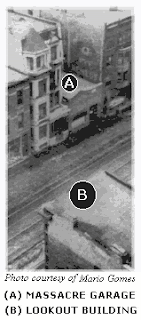Slaughter on Clark Street
1929
slaughter on clark street
2122 clark street "I want peace and I will live and let live."
Al Capone
There were seven men in the garage at 2122 N. Clark Street, Chicago, on February 14, 1929 St. Valentine's Day. Five of them were in the Bugs Moran gang and they were waiting for the boss, who wanted a consignment of liquor convoyed from the Canadian border through the Prohibition force's paper curtain. Moran had survived the five bloodiest years of the underworld wars to emerge as the successor to his executed chums Dion O'Banion and Hymie Weiss in command of the anti-Capone cabal on the North Side.
But the black touring car that pulled up outside the garage at 10:30 that morning wasn't carrying the affluent Mr. Moran. It looked more like a police car. There was an alarm bell on the running board and a gun-rack behind the front seat. And out of it, moving briskly in the light snow and 18-degree cold, stepped two men dressed as policemen and two in civilian clothes. A fifth man in uniform stayed at the wheel. Inside the garage, the quartet whipped open their overcoats and produced two sawed-off shotguns and two machine guns. Somebody barked out an order "Line-up! Put your noses to the wall!" and then the artillery began to go off. The seven men standing against the red bricks were cut down in a withering cross fire.
The four messengers of death left in a deceptive formation. The two in civies came out first, hands high, herded by the two in uniform as though they were under arrest. Sam Schneider, the tailor next door, heard the great clatter and saw the quartet depart; he thought the cops were simply taking in an errant pair trapped in gunplay in the cavernous booze drop. Witnesses in the rooming house across the street had the same idea.
frank gusenbergThe real police arrived in force in due time and tiptoed into the giant pool of blood in the garage. There lay the ripped-up bodies of Pete Gusenberg, James Clark, Adam Heyer, John May and two casual visitors, Al Weinshank and Dr. Reinhart H. Schwimmer, a young optometrist who knew some of the Moran boys. Frank Gusenberg, with fourteen slugs in him, had crawled twenty feet toward the garage door and was still alive. In the hospital Lieutenant Tom Loftus, a long-time authority on the bad Gusenberg boys, stood over his cot:
"You're dying, Frank, and Pete is dead. Tell us
who did it."
"Coppers," the gunman answered. "It was coppers."
"What coppers?"
"I didn't know them."
"Tell me the truth, Frank. The men who did this ought to go to the gallows. We wanna hang 'em."
"That's all I know. Coppers done it."
the massacreLoftus kept up the soft, gentle interrogation for three hours. Finally, Gusenberg gasped out his last: "It's getting dark, Tom. I'm cold awful cold. Pull the covers up over me."
Frederick D. Silloway, the Prohibition administrator in Chicago, submitted that the murderers were indeed policemen five sinful gendarmes who had hijacked some Moran booze and then decided to knock him off lest he tattle. The Federal people promptly transferred the talkative Silloway to a less sensitive post far from the stormy shores of Lake Michigan.
bugs moranSomeone else said the Purple Gang of Detroit had staged the mass executions the worst in the whole gory history of the underworld over some business spat with the Moran organization, but Bugs himself would have none of it. "Only the Capone gang kills like that," said the hardy North Side beer baron.
Moran had a point. His troubles with the racket overlord had been multiplying for months because he had allied himself with the Aiello Brothers' gang in a struggle to take over the Unione Sciliana. Moran was suspect in the slaying of two Unione Siciliana presidents, Anthony Lombardo and his predecessor, Pasqualino Lolardo, knocked off in his own living room after four of his supposed pals had sipped his rare wines one afternoon. Beyond that, Bugs had been having troubles with Vincenzo Demora, better known as "Machine Gun" Jack McGurn, who had been raiding North Side liquor drops on harrying missions ordered by Scarface Al.
machine gun jack mcgurnOn February 27, thirteen days after the killings on North Clark Street, the police brought in McGurn and John Scalisi, ace artilleryman of the Terrible Gennas when they presided over the Unione Siciliana. McGurn furnished an effective if unchivalrous alibi. He said he had spent St. Valentine's Day in a cozy room in the Hotel Stevens with his best girl, so the indictment was thrown out. Scalisi hadn't thought to furnish such an iron-clad story and was held for trial, but unfriendly hands saved the state the expense.
massacreScalisi and his torpedo mate, Albert Anselmi, were done in with ball bats and pistols along with Joseph Guinta, newly installed by Capone as head of Unione Siciliana. Capone supposedly threw a small private banquet for this trio and then, when they were groggy on vino and high-calory viands, bashed in their heads and sent some boys out to finish the job with revolvers. The story was that Capone was unhappy about the St. Valentine's Day bloodletting and doomed Scalisi, Anselmi and Guinta for being so frisky.
What Capone feared was that the spectacular massacre would turn on too much heat; he was right. Chicago's tattered forces of decency got madder than ever. The newspapers compared the Midwestern metropolis to the wildest frontier towns of the old West and talked of a complete breakdown of law 'n' order. There were suggestions in Congress that the Marines be sent out to take the situation in hand.
And now the outcry took hold.
The end was at hand for Al Capone.

